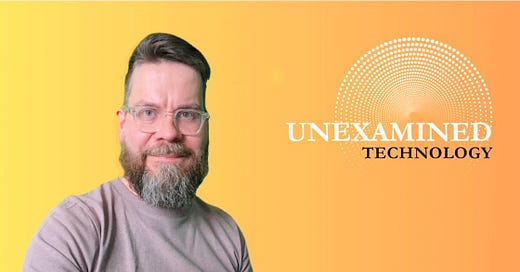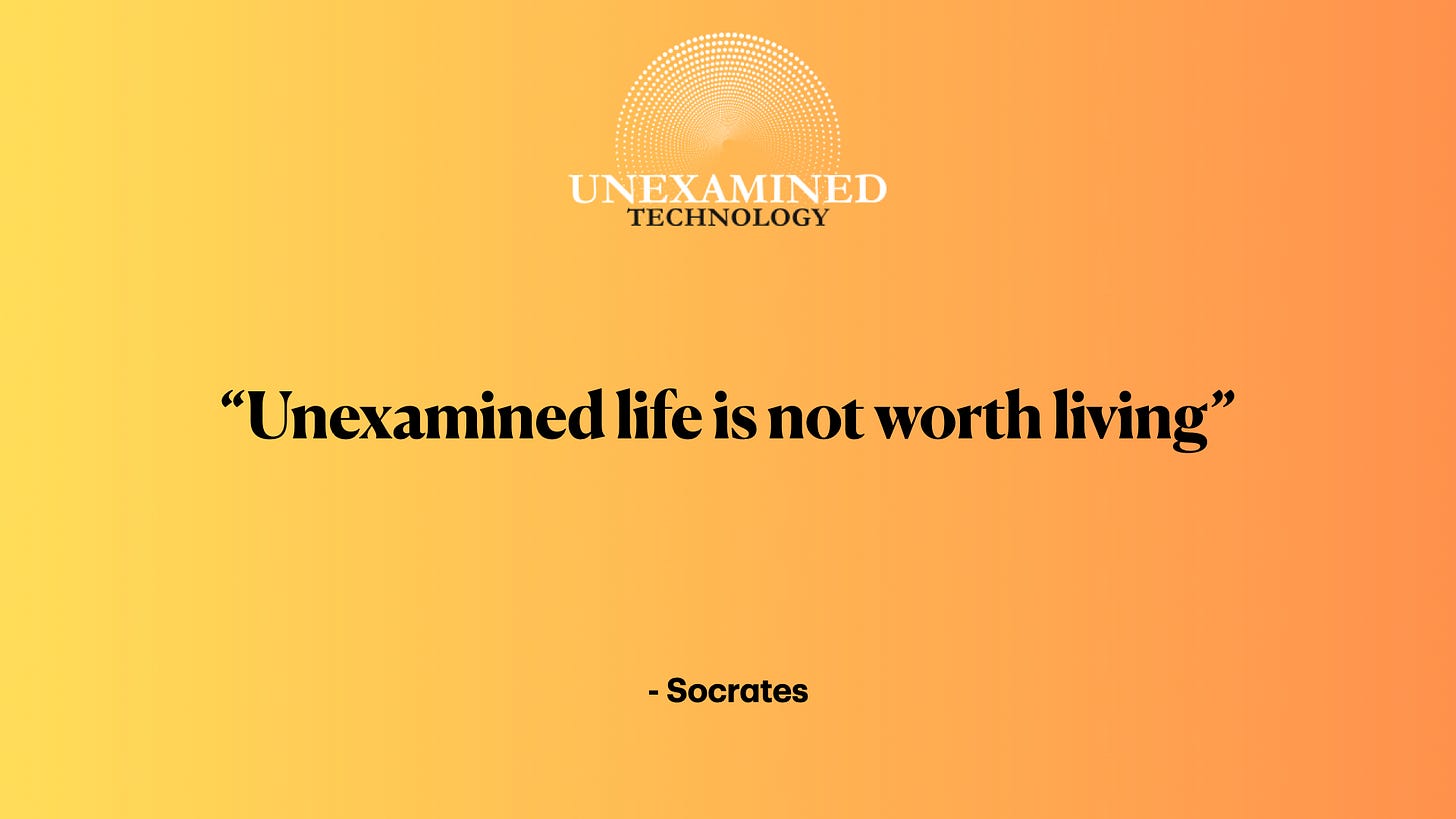It seems to me we are witnessing more calls for an examined relationship to technology. It also seems we are living through a critical decade of AI resurgence where directions for the ways in which we engage with knowledge, education, and nature in the coming decades are being defined.
I am increasingly believing, following people like
and others, that we need to prepare our children to work at the ruins of this civilisation, regularly called ‘modernity’. It is a civilisation that has overreached its limits and therefore is coming to an end, as civilisations do.To be clear, this does not mean an apocalyptic end to the world in the ways that Hollywood would imagine it, or the Bible would present it. It is apocalyptic in the original meaning of the word as a ‘revelation’ or an ‘uncovering’. It refers to a realisation that the world as we knew it cannot continue to exist any more and we need to start building towards a new civilisation, built on the ruins of this one.
I want to emphasise that despite the critical situation with the planet, this perspective is not all doom and gloom. As Hine suggests, it’s about salvaging the good things from the past century or two - such as medicine - and trying to figure out what types of skills and people we need to do the restorative work at the ruins.
Ruins can be a good thing. But embracing them as a glass half full type of thing also necessitates a thousand-year view, a selfless ability to think about what the seeds we plant at the ruins can grow into, over centuries. In future posts, I will explore in my small way what that might mean in the context of technology. The questions include: for workers at the ruins, which technologies should we keep holding on to? How should we reimagine the role and reach of technology going forward? How can a sense of connectedness to something greater - spirituality - help in this?
After this brief look forward, I want to close a chapter on the content here at Unexamined Technology so far, a couple of months after launch. What follows is a summary of the topics covered with links to the original posts.
Unexamined Technology: the first chapter
In the introductory post to the newsletter, I wrote about how our unexamined relationships with technology stem from fascination, both intellectual and aesthetic, or need to adapt. Humans have built machines and devices that exert control over nature in extraordinary ways: by manipulating nature and its resources, or communicating over vast physical distances in milliseconds.
The particular perspective to examining technology I propose with this publication is about waking up into cultivating an examined relationship to technology, a relationship that cultivates human flourishing.
This newsletter is also about finding useful guidance from the wisdom traditions, both secular and spiritual. It is about waking up to the relevance of complementary and morally sound world views external to technological development. UT tries to capture what it means to reward both everyday and advanced technologies constructive, moral, finely proportioned attention.
Critical technical awakenings
In the above-linked post I wanted to introduce Philip E. Agre’s 1997 essay, where the computer scientist describes his personal awakening to alternate viewpoints to the technological mindset that had dominated his life. Agre describes ‘waking up’ from his inability to learn nontechnical disciplines on their terms, and how he insisted on trying to read everything as a narration of the workings of a mechanism. Agre’s proposed practice entails reflexive critique, i.e. a comprehensive examination of the assumptions underpinning technological disciplines.
Agre has inspired several subsequent scholars, among them a more recent call for a critical technical awakening, which means letting go of an absolute belief that the technical-empirical world view is the primary way to approach problem-solving, complex questions, and ultimately have a grasp of reality.
Towards the end of the post, I suggest a technologically informed community is needed to continue such activities to keep pace with the developments in AI, spatial, and quantum computing and all their applications across various sectors. I hope to translate this aspect into practice by experimenting with Substack’s chat feature going forward.
Imagination and intuition: the two ‘Is’ we need to include in the discussion about AI
The next two posts were essentially about uniquely human concepts that are useful to keep in mind when thinking about the capabilities of current (and future) AI. For example: what if the more pertinent question about AI is not how robust it can be in terms of intelligence, but rather if it can ever intuit or imagine?
Efforts in modelling imagination and intuition into AI solutions are at best approximations or simulations of what they are trying to capture. In that, they represent objectives that the left hemisphere of our brain leans towards, with the shortcoming that the left hemisphere does not understand the limits of its thinking and reach (according to Iain McGilchrist’s hemisphere hypothesis). This stance regularly leads to mistaking the map for the territory — in the context of AI, that tends to manifest as overlooking the embodied aspects of knowing.
Consequently, there is no thought in play in how the transformer algorithms work in LLMs. A generative AI tool primarily operates on the level of written language with probabilistic methods. Therefore, it presumably privileges the left hemisphere’s take on the world. The tool focuses on labelling things, categorising, and paying attention to the individual parts rather than the whole. Such tools cannot leverage concepts that are not put into words or other languages of intellect, such as formulas, equations, or code.
I discussed Samuel Taylor Coleridge’s notion of primary imagination versus secondary imagination. He saw primary imagination as ‘nature’s imagination’ and how we perceive the world as it is, spontaneously and without intentions (as in Blake’s poem that I started with). We employ secondary imagination when we create a new meaning or an object. For Coleridge, nature’s sounds are the primary music, and man’s compositions count as secondary music, drawing from the primary source.
The main reason for AI’s inability to grasp intuitions is the lack of embodiment, i.e. the experience of being in the world and the uncertainty that one’s knowledge of mortality brings to everyday human existence.
Philosopher Henri Bergson wrote about intuition as ‘unconscious intelligence’ and how “Intuition may help us grasp what intelligence fails to provide.” These observations are useful in evaluating where the statistically operating AI models stand, limited by the training data that creates the only world they can parse, while not realising their limits.
Beyond technology-dominated world views
My next post addressed the shortcomings of a technical-empirical indoctrination. Having worked in technology for 20+ years, my observation is that the majority of people working in technology have, knowingly or unknowingly, adopted a world view that does not entertain intuitions about immaterial things that defy empirical study. We aren’t comfortable with phenomena that cannot be explained with words, models, formulas — with intellect.
Young people entering education in the various technology-related disciplines are guided to adopt values that privilege technical and empirical interests for knowledge. Focusing on this set of values alone creates an artificial rift between technology and other socio-cultural dimensions — including ethics and spirituality. In the process, a false dichotomy emerges between the rationalist engineering mindset and more qualitative intellectual pursuits, such as the humanities and the arts, let alone spiritual endeavours.
Technologists can benefit from tools for thought that invite them to reconsider what spirituality means. For example, spirituality can be approached as a set of practices and perspectives that help in reaching beyond ordinary, everyday existence. Such intuitions complement the workings of the rational intellect and cultivate intuitions about meaning and connectedness beyond the technical and empirical; beyond the intellect and language and towards what can’t be said but only felt.
Spiritual traditions and teachers have for centuries acknowledged that happiness emerges from letting go of beliefs; it lies within, not in our thoughts (of craving, analysing, planning, ruminating, clinging to things) but in our ever-present awareness.
In the second part I suggested that anyone identifying themselves as spiritual needs to acknowledge both
intuitions that tell them that there exists something greater; something that defies description beyond our everyday existence, and
practices with which to cultivate and explore those intuitions, in service of searching for a more fully lived life.
The idea is that the combination of the two, intuitions and practices, is helpful for thinking about what spirituality means for you — and indeed, whether you can honestly characterise yourself as a spiritual person.
I suggest everyone needs to find their eclectic mix where intuitions and practices meet. Thus far, we have been laying some groundwork in this newsletter - I hope to continue pointing you to practices that I have found useful. Some of them will deserve a post of their own, some of them I will refer to via the readings, videos, etc, I recommend. In all of this, I am very much a student myself; I claim only intermediate experience at best.
Thank you for reading. As always, I leave you with a piece of contemplative algorithmic art:
With love and kindness,
Aki













Great thought Aki. Something like Schumpeter's 'Creative Destruction' perhaps in the paradigm of technology.